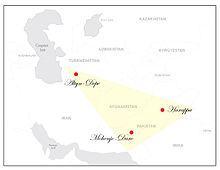Altyndepe

Altyndepe (Алтын-Депе, also Altyn Depe , German: Golden Hill ) is a Bronze Age settlement in the south of today's Turkmenistan . Excavations have shown that the settlement was inhabited from the 5th millennium to the 18th century BC.
location
Today the remains of the settlement Altyndepe lie in the south of the Central Asian state of Turkmenistan, in the province of Ahal . The surroundings of the former settlement are today shaped by the hostile Karakum desert . The M37 , one of the most important highways in Turkmenistan, runs north of Altyndepe . For example , Altyndepe can also be reached from the oasis town of Tejen . The Meane Baba mausoleum is also nearby .
Excavations
Intensive excavations were carried out in the region in the 1970s and 1980s, which were largely promoted by the Academy of Sciences of the Soviet Union . Several layers were uncovered, forming a hill 22 meters high, with the deepest layer being discovered at a depth of eight meters. Today only this shapeless hill is visible of the once important settlement, which is why the remains are hardly of tourist, but all the more of scientific importance.
Settlement history
The oldest traces of settlement come from a six hectare settlement from the 5th millennium BC. Ceramics have been preserved from this time , which indicate a highly developed art of pottery for the time .
The excavations from the 4th millennium BC indicate a doubling of the settlement area to twelve hectares. In addition, other ceramics and several statues that mainly depict women's bodies were found.
At the beginning of the 3rd millennium , Altyndepe was already an urban center with an area of 25 hectares. A city wall with a thickness of up to two meters surrounded the center of the settlement. The ruins of a sanctuary and several graves were uncovered from this time.
Heyday
The settlement reached its heyday at the transition from the 3rd millennium to the 2nd millennium BC when Altyndepe was the most important center of early civilizations in Central Asia. The excavations suggested a clear division of the city into several quarters, including a craftsmen's quarter with narrow streets, larger apartment blocks and numerous ovens. The wealthy citizens lived in the so-called aristocratic district, where wide streets and houses with an area of up to 100 square meters were exposed. In addition, several terracotta statues, art ceramics and daggers made of bronze and copper were found. A large part of the population worked in the fields in the vicinity of the settlement, which were made usable through irrigation channels.
The most striking building in the former settlement was a ziggurat with a height of twelve meters and a side length of 26 meters. The complex was probably dedicated to the moon god, who was symbolized by a bull's head. The style and use of this building indicate a close cultural and religious exchange with the cultures of Mesopotamia .
Downfall
From the 18th century BC there are no more traces of settlement. The downfall of the prosperous settlement Altyndepe is still not conclusively justified. Conjectures range from abandonment of the city due to lack of water to the influence of ranchers tribes that made their home in Central Asia.
Individual evidence
- ↑ Altyndepe. Retrieved August 22, 2019 (de-US).
- ↑ ltin (ALTYN) TEPE, a settlement of the Neo-lithic period and Bronze Age in the south of Turk-menistan near the village of Miana. December 15, 2007, accessed August 22, 2019 .
- ↑ STAN TOURS - Turkmenistan - Ahal - Altyn Depe. Retrieved August 22, 2019 .
- ↑ Ashgabat Vicinity - Altyn-Depe. Retrieved August 22, 2019 .
- ↑ Altyn Depe. Retrieved August 22, 2019 .
- ^ Beate Luckow: Turkmenistan . Trescher Verlag, Berlin 2019, p. 136 f .